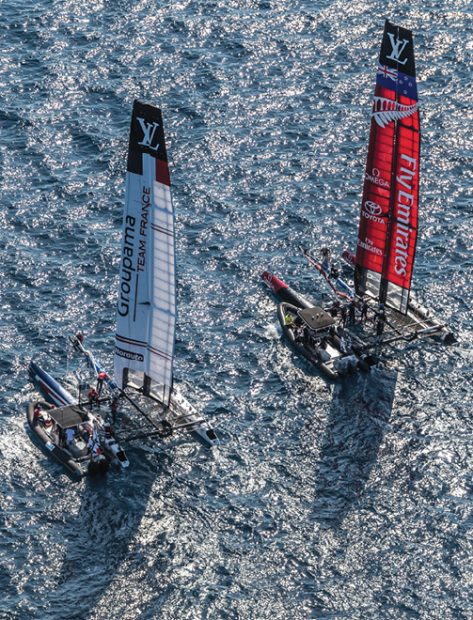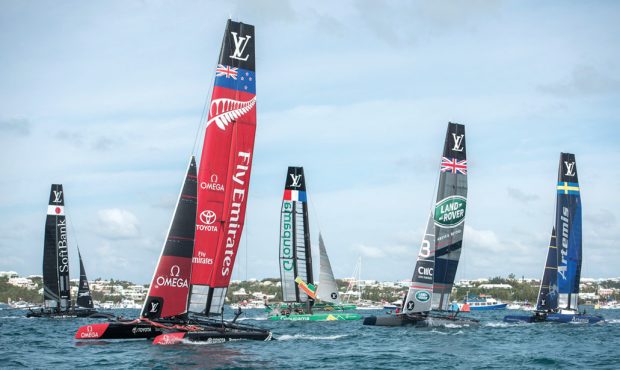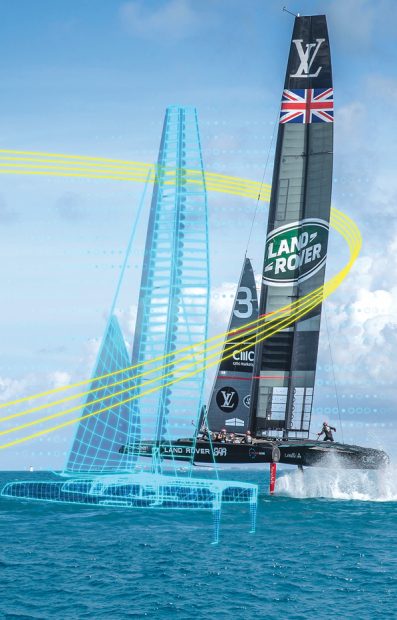
The Land Rover BAR team uses Python scripts in Siemens NX to tie in simulation, design and automatic shape generation. Image courtesy of Siemens PLM Software.
Latest News
May 22, 2017
The rules allow the competing teams to begin testing their AC50 (America’s Cup) race boats in Bermuda 150 days prior to the event. But long before they touch the azure waters of the Great Sound in Bermuda, many of these boats have already set sail hundreds of times in oceans of bits and pixels, having been tested in the rough winds and waters constructed from partial differential equations in computational fluid dynamic (CFD) programs.
 The Land Rover BAR team uses Python scripts in Siemens NX to tie in simulation, design and automatic shape generation. Image courtesy of Siemens PLM Software.
The Land Rover BAR team uses Python scripts in Siemens NX to tie in simulation, design and automatic shape generation. Image courtesy of Siemens PLM Software.The Rise of Hydrofoils
In the 35th America’s Cup presented by Louis Vuitton, the defender Team Oracle USA faces five worthy opponents: Artemis Racing, including Olympic champions; Emirates Team New Zealand; Groupama Team France; Land Rover BAR, led by Sir Ben Ainslie (previously with the Oracle team); and SoftBank Team Japan, led by Dean Barker (previously with Team New Zealand).
The teams design and build their own America’s Cup Class (ACC) boats—about 15m (nearly 50 ft.) in length, built according to the Cup’s official specifications. A common characteristic of the boats is the use of wing-like hydrofoils, a recent development in the sailing world.
“The boats are aiming to be foiling right around the race course,” observes Russell Coutts, America’s Cup CEO. “The boats today are faster than they were three years ago, and they are smaller boats ... Where we used to watch races that took an hour and a half, we’re now seeing a race last around 22 minutes with essentially the same number of maneuvers.”
“When we build a prototype boat and test it, we can use sensors to measure the pressure on the components, the deformation in the fiber parts and so on.”— Rodrigo Azcueta, Land Rover BAR
“At high speed, drag and seakeeping become big issues aboard any vessel, particularly offshore monohulls ... Rising above the water’s surface [a mode of sailing possible with foiling] not only reduces drag, but might help to reduce structural risks and make handling at speed easier,” points out Matthew Sheahan in his July 2015 Yachting World feature, “The foiling phenomenon: how sailing boats got up on foils to go ever faster.”
The design teams involved in the America’s Cup spend a good part of their time figuring out the best foil shape, analyzing the tradeoffs between lift and drag, and studying the performance of the prototype boats during the test period. According to the race rules, testing in the waters at the site is only available for a small window of time. Therefore, the teams rely on a range of digital design and simulation tools to refine and perfect the performance of their boats in advance.
The Quest for the Golden Ratio
First founded in 2000, Oracle Team USA wrestled the trophy away from the Swiss team Alinghi in the 33rd America’s Cup in 2010 (Valencia, Spain) using a wing sail design, and emerged victorious once more in the 34th America’s Cup in 2013 (San Francisco). With two past victories in tow, the Oracle Team heads to Bermuda this year to defend its title.
“We built solid element models of the hydrofoil. They’re each roughly between 500,000 and 1 million elements. We were looking at about five different designs at the same time.”— Aurelien Miller, Artemis Racing
“For the most part, the boat is sailing on its hydrofoils, which are essentially wings,” says Len Imas, CFD specialist from Team Oracle’s design team. “A normal sailing vessel keeps its hull in the water and is driven by hydrostatics—basically, Archimedes’ principles. On the other hand, the race boats in the America’s Cup are supported by their wing-like foils that generate lift.”
Because the boats mimic airplanes with the use of hydrofoils, they also face many of the same aerodynamics challenges encountered by airplanes. “Once you put underwater wings on a boat, you have to worry about how you control it,” says Hal Youngren, aerodynamics/hydrodynamics engineer from Team Oracle’s design team. “Our rudder—an important feature of the boat—acts like a tail does on an airplane to stabilize the boat.”
If you can think of the boat’s rudder as the tail of an airplane, you can think of the hydrofoils as its wings. “The catamarans are popular in this race because they can fly above the water using hydrofoils,” says Aurelien Miller from Artemis Racing’s engineering team. “When the boat is flying one meter above the water, the only points of contact between the boat and the water are those hydrofoils. The foils are quite similar to airplane wings.”
But sailing on wings in water is not the same as flying through the air. “The flying stability is a big challenge especially in the daggerboard development,” says Andrea Vergombello from the design team of Groupama France. “You can obtain the best board in terms of performance, but you need to respect some stability criteria in order to create a foil that’s also easy to handle. The balance between pure performance and stability require lots of work and experience, especially on the water.”
Yachting World’s Sheahan points out: “While foiling clearly appears to reduce the wave-making drag considerably, there is no free lunch. Lift and drag go hand in hand and what happens beneath the surface can sometimes wipe out any benefit above. For example, tilting a foil at a large angle of attack may create lift, but there will often be a large amount of drag, too.”
America’s Cup boat design engineers and simulation analysts need to focus on both air and water. “We look at the areas of the boat exposed to wind and water, so hydrodynamic and aerodynamic are equally important for us,” says Rodrigo Azcueta, a member of Land Rover BAR’s concept team. “As water and air flow around the body of the boat, it generates forces. We’re interested particularly in the resistance that creates drag, and the forces that create lift. The lift-to-drag ratio is what we’re trying to optimize.”
The Boiling Point
All the AC50 race boats are equipped with hydrofoils, so they must confront cavitation or “cold boiling,” associated with rapid pressure changes in liquids. Cavitation occurs at high speeds and causes formation of small vapor cavities or bubbles.
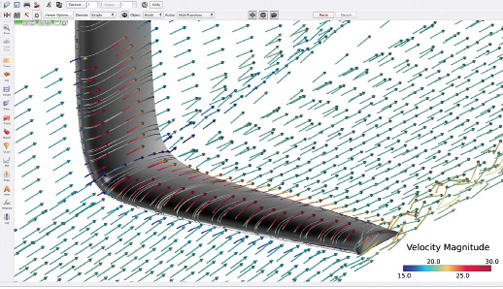 An AcuSolve computational fluid dynamics analysis of flows around a daggerboard is visualized in AcuFieldView. Image courtesy of Altair.
An AcuSolve computational fluid dynamics analysis of flows around a daggerboard is visualized in AcuFieldView. Image courtesy of Altair.“Cavitation prevents the boat from going faster,” explains Azcueta. “When we build a prototype boat and test it, we can use sensors to measure the pressure on the components, the deformation in the fiber parts and so on. We can also have cameras pointed at the components so we can observe the cavitation, to see if it appears.”
Emirates Team New Zealand also makes use of sensors to collect data and improve boat design. “There are sensors all around the boat looking at different aspects, whether it’s the loads on the rudders, for instance, or the daggerboards,” says Marty Yates, IT manager for the Emirates Team New Zealand in a video produced by HP, an official supplier of the team. “We get hundreds of data points coming off per second and then that’s all analyzed in terms of the boat speed, the direction, the strains … We’ve got to be able to figure out how much higher we can push things before they’ll break, which is maximizing performance and boat speed.”
“The aero- and hydrodynamic components of our official race boat are the results of several optimization steps, including performance, reliability, structure criteria and weight reduction.”— Andrea Vergombello, Groupama France
The team uses an HP Z840 workstation as a dedicated SQL server to handle the number crunching, mobile HP workstations for design and another HP Z840 for ANSYS simulation analysis.
Even though the test sailing period is limited, the teams have the option to build scale models and prototype boats to test elsewhere, but that option is also limited by the cost involved. “Building boats and testing them is very time consuming,” says Land Rover BAR’s Azcueta. “We rely on digital simulation to shorten the design process.”
“Whereas you can put an airplane in a wind tunnel or a boat in a towing tank, you can’t really do that to understand a catamaran, because it’s a complex interaction of wind, water, hydrodynamics, and aerodynamics,” explains Stephen Ferguson, Siemens PLM Software’s marketing director. “Many of the teams in America’s Cup use CFD for aerodynamic and hydrodynamic tuning.”
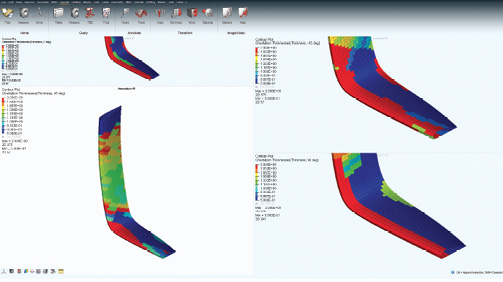 OptiStruct was used by Artemis Racing to perform structural analysis on a laminated composite daggerboard. Image courtesy of Altair.
OptiStruct was used by Artemis Racing to perform structural analysis on a laminated composite daggerboard. Image courtesy of Altair.Ferguson was previously employed by CD-adapco, makers of the STAR-CCM+ simulation software suite. The software is known for robust CFD tools and features. Last year, Siemens PLM Software acquired CD-adapco, making STAR-CCM+ part of its Simcenter portfolio.
“Our main challenge in simulation is cavitation and fluid-structure interaction (FSI),” says Azcueta. “The physics involved is very complex.” The complexity of the simulation comes from the need to employ not just one type of physics but multiple types. Simulating the waves’ potentially damaging impact on a boat’s structure, for example, involves not just fluid dynamics but structural mechanics. Such simulation calls for multiphysics solvers or code-coupling, enabled by a limited number of simulation packages.
Automated Shapes, Scripted Meshes
On the day of the race, speed is the deciding factor. But long before the race, when the design teams are subjecting the 3D digital models of their boats to CFD tests, a different kind of speed offers an advantage—the speed with which engineers can study and evaluate dozens or hundreds of designs simultaneously.
“We look at a very large number of designs,” says Land Rover BAR’s Azcueta. “We generate parametric models of the critical components, like the wing, the daggerboard and the foils. The design parameters like lengths and thicknesses vary. Then we generate hundreds of shapes and run hundreds of simultaneous simulations. We send them all at once to the high performance computing (HPC) queue. In a few days, we get the results back when all these simulations are finished. That’s when we usually build a force model” to study the effects of different forces on the boat’s components.
Land Rover BAR uses ESTECO’s modeFRONTIER software to automate the foil design process. The team uses Siemens NX to design the shape of the boat, and STAR-CCM+ to run CFD simulation on the design.
“We added support for Python scripts in NX,” says Paul Brown, Siemens PLM’s senior marketing director. “So inside NX, engineers can tie simulation, design and automatic shape generation. That gives a team like Land Rover BAR the ability to quickly go through lots of iterations, evaluate them.”
“The important thing about this process is, it’s entirely automated, so basically the engineers can change the design parameters in response to the CFD results they see to run another set of simulations,” adds Ferguson.
The engineering team of Artemis Racing turns to Altair Engineering, known for its OptiStruct solver and HyperWorks computer-aided engineering (CAE) software suite. HyperMesh, part of the HyperWorks bundle, is known for accurate, efficient meshing, a critical pre-processing requirement in finite element analysis (FEA).
“We’ve got to be able to figure out how much higher we can push things before they’ll break, which is maximizing performance and boat speed.”— Marty Yates, Emirate Team New Zealand
“If we were looking only at the structure, we could run the simulation on a single computer,” says Artemis Racing’s Miller. “But we were also coupling structure simulation with fluid calculation. So we ran the jobs on our HPC server. Usually we use around 20 cores for linear calculations, 300 for nonlinear calculations.”
The Artemis team is building its foils with composite materials, which offer certain structural advantages. But the decision also puts a burden on the simulation software. “If it were metal, we could apply tetrahedral meshes. But meshing composite design is harder. We used hexahedral meshes, which require a lot more care and attention,” says Miller. “We built solid element models of the hydrofoil. They’re each roughly between 500,000 and 1 million elements. We were looking at about five different designs at the same time. With the use of HyperMesh, we cut the preparation time by half.”
Every team raced against time and the limits of physics in designing their boats before they could race one another.
“Computer technology in the America’s Cup is one of the main factors, especially now in the 35th America’s Cup where we’re heading toward the most technologically advanced boats ever seen,” says Yates from Emirates Team New Zealand.
Emirates Team New Zealand uses SOLIDWORKS and AutoCAD for design, then turns to ANSYS multiphysics tools to simulate how structural composite components will interact with the air and water under different circumstances. ANSYS DesignXplorer, integrated into ANSYS Workbench, is used to explore and optimize the designs.
“There’s an enormous amount of tradeoffs among structure, control and hydrodynamics.”— Hal Youngren, Team Oracle
“The aero- and hydrodynamic components of our official race boat are the results of several optimization steps, including performance reliability structure criteria and weight reduction,” says Groupama France’s Vergombello. Groupama uses Dassault Systèmes’ Designed for Sea industry solution to create the general shape of the catamaran. Designed for Sea is based in Dassault Systèmes’ 3DEXPERIENCE platform. It targets naval architects, engineers and designers in shipyards. As such, it includes tools to help ensure compliance with industry regulations and classification standards.
Groupama uses Rhino, a surface-modeling program, and Grasshopper, a plug-in to Rhino, to design the boat’s foil. To manage the optimization process, it uses ESTECO’s modeFRONTIER software. “In the first period, modeFRONTIER software supported our 2D section optimization, both for the daggerboard and the rudder ... We use it to find the best way to optimize a 2D foil cross-section, starting from working conditions and constraints. During the second stage in the campaign, other team members started using modeFRONTIER to optimize the daggerboard’s 3D shape,” says Vergombello.
Team Oracle has a multistage process. “We use the CAD software to generate the shape of the foil and other parts of the boat—like wings and hulls,” says Team Oracle’s Imas. “Then we use a broad set of simulation tools to progressively improve the design in subsequent iterations.”
One of the tools the Oracle team is using is Pointwise, a software program for generating CFD mesh models. “Pointwise’s advantage is that it can be scripted,” says Youngren. “It can take our CAD geometry, cut it at water surface, re-mesh it and then dump it into our analysis tools. It’s basically automated using the scripting language called Glyph that is built into Pointwise.”
Different Assumptions, Different Bets
Using time-tested fluid dynamics and structural mechanics principles, simulation and optimization software programs provide answers based on the users’ inputs and constraints. For example, a simulation package can calculate the stress distribution on the surface of the hydrofoil based on the forces specified by the user. Similarly, an optimization program can suggest the best geometry for the hydrofoil based on the loads and the weight limits specified by the users. Therefore, the gamble in the foil design may ultimately come down to the assumptions each team makes about the sailing conditions, which translate to the parameters they feed into the simulation software.
“It turns out, in Bermuda, the range of possible sailing conditions is quite a bit larger than they were at the site of the last America’s Cup [the San Francisco Bay],” notes Youngren. “Most of our hydrodynamic design efforts are split into designing for high-speed conditions (for stronger wind), and lower speed conditions (for lighter winds and slower sailing). You need to look at both because it’s very difficult to use a light-air foil to sail in high-speed conditions, and vice versa.”
Imas says many questions come into play during design and optimization. “Do you put more weight on designing for the heavier winds? Do you design for best sailing in lighter, intermediate winds? Or do you try to account for both equally with the same foil design? These assumptions and design goals push you down a specific design path,” he says.
Encoding the Wind’s Power and Reducing Weight
The best types of simulation are those driven by real-world experience and data, obtained from physical tests and past records. The racing teams in the America’s Cup have a narrow window to test their AC50 boats at the race site; therefore, collecting data during those test runs is all the more critical for subsequent design refinements.
Land Rover BAR turned to Renishaw, a recognized name in the metrology industry, to produce a bespoke magnetic encoder. According to Renishaw, the encoder system is “designed for integration into hydraulic, pneumatic and electromechanical actuators as a feedback element for position or velocity ... The position encoders were installed on the control surfaces of both the wing (flaps) and the port and starboard rudders.”
The encoders help measure the degree of camber, or curvature, in each of the wing sections during the boat’s operation. “In lighter wind, you have more camber; in stronger wind, you reduce camber because you effectively have too much power and you’re trying to spill some of it,” says Paul Campbell-James, Land Rover BAR’s wing trimmer. “The Renishaw encoders tell me the ratio between the different levels. I’ll use that to determine the best twist profile going up the wing to give the boat maximum speed.”
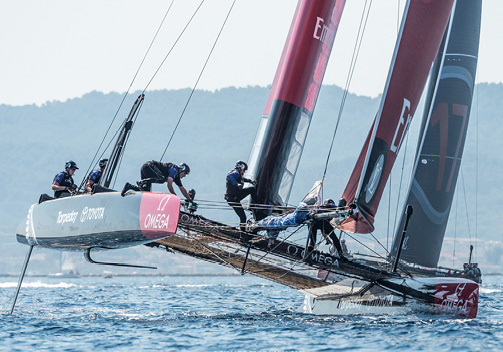 In addition to cross-discipline engineering technology working together, everyone on each America’s Cup team must work together for victory. Photo by Ricardo Pinto/via ACEA.
In addition to cross-discipline engineering technology working together, everyone on each America’s Cup team must work together for victory. Photo by Ricardo Pinto/via ACEA.Renishaw has also manufactured several hydraulics parts for Land Rover BAR using additive manufacturing (AM), which helped reduce weight. For example, the weight in a new AM manifold design was reduced by 60%, with an increase in performance efficiency of better than 20%.
The Choreography of Victory
On the day of the race, the racing teams confront one of the big unknowns that can change their fate—the weather. “The night before the race, we look at weather forecast. Based on that forecast, we tune certain components, the same way a race car team would tune their vehicle,” Land Rover BAR’s Azcueta says. “The wing and the boat are fixed, but we have different foils to choose from, and we can make small adjustments.”
Having the best boat or foil design may provide an advantage, but it alone cannot promise victory. “You also need the best helmsman, wing trimmer and crew to control and maneuver the boat,” says Team Oracle’s Youngren. “Sailing one of these AC50s is more like a choreographed dance—everyone on board has to move very precisely.”
The choreography also extends to the design work that takes place months or years prior to the race. In the simulation and analysis sessions before the physical prototyping, people with different backgrounds have to come together. It’s highly improbable that a design team could find a single expert who understands structural mechanics, aerodynamics and hydrodynamics. In most cases, experts from these different disciplines have to work together to build and refine the boat.
“My background is in aerodynamics and aerospace,” Youngren says. “My colleague Len Imas’s background is in CFD. We have a fairly small group of hydrodynamicists, but we work closely with designers whose strength is in control systems design or structural engineering. There’s an enormous amount of tradeoffs among structure, control and hydrodynamics.”
During the testing period and the race, each team observes the others. They take note of the rivals’ design ideas, along with the advantages and disadvantages noticeable on the water. They then incorporate these insights into their own boats’ designs, germinating ideas for the next America’s Cup. Thus, with each race, a better, faster generation of catamarans is engineered.
For more info, visit
Altair EngineeringANSYSDassault SystèmesESTECOGrasshopperHPPointwiseRenishawRhinoSiemens PLM Software
For America’s Cup Background, visit
35th America’s CupArtemis RacingEmirates Team New ZealandGroupama Team FranceLand Rover Ben Ainslie Racing (BAR)SoftBank Team JapanTeam Oracle USAYachting World article
Subscribe to our FREE magazine, FREE email newsletters or both!
Latest News
About the Author
Kenneth Wong is Digital Engineering’s resident blogger and senior editor. Email him at [email protected] or share your thoughts on this article at digitaleng.news/facebook.
Follow DE






